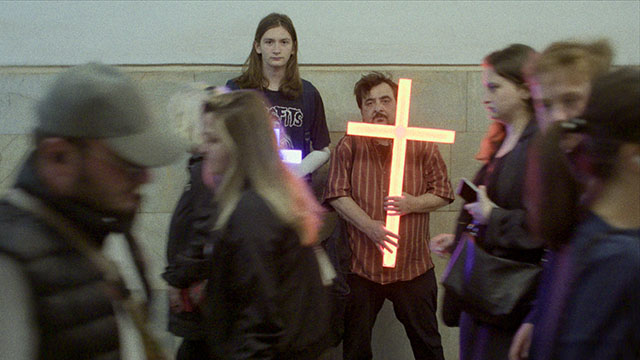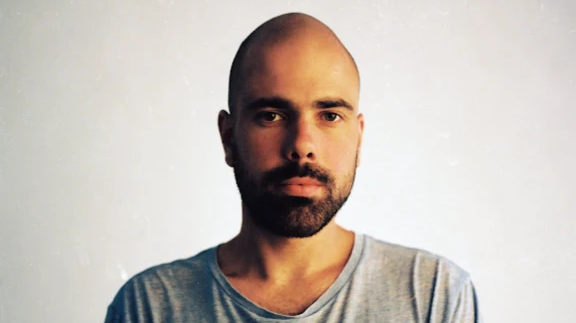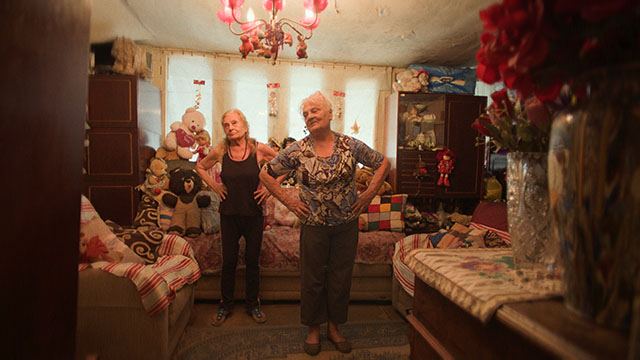Interview with Tato Kotetishvili about the film, “Holy Electricity,” Locarno Film Festival 2024

Fresh, different, unusual, unconventional could be a few words to describe the directorial debut of Georgian filmmaker and cinematographer Tato Kotetishvili. Rambling, eccentric and slightly kooky could be another set of adjectives to describe “Holy Electricity.” The film is a tale of modern times, an ironic take on capitalism, at least its Georgian strand, a film with a free, episodic structure, composed of a series of moments, short scenes, vignettes, elevated by decadently beautiful compositions and striking imagery that will linger in your mind long after you forgot its minimalist storyline.
The film’s beating heart is the friendship between two oddball characters, Gonga, a youngster with long hair and a Misfits T-shirt and his older cousin Bart, a trans man and junk dealer, who’s trying to be a father figure to Gonga. Their new entrepreneurial endeavor is turning old and rusty crucifixes into bright and shiny ones, then going from home to home and offering them, for a price, of course, to various inhabitants of Tbilisi. “What are they for?” asks one of them. “I don’t know, they are beautiful”, comes the answer. Hesitantly: “Would you like to buy one?” “No, thank you”. Fortunately, not all potential customers are as unenthusiastic as this one, and Tbilisi’s gritty skyline turns gradually glowy, an almost surreal metamorphosis, in keeping with the director’s unique vision.

The film struck me as an ironic take on capitalism as well as religion. A lot of the dialogue revolves around how much things cost and how to sell things, especially in the first scenes. The “products” that are being offered for sale, the neon crucifixes (basically an age-old object that gets a veneer of modernity, the neon element, and is now sold for so much more) also contribute to this. But they also serve as an ironic critique of religion, since the neon is basically “artificial light” and quite harmful for health, in contrast to “natural light”. Not to mention the “spiritual light”, the guidance that religion is supposed to bring. But the film is so open and fluid, it invites many interpretations.
“Holy Electricity” premiered at Locarno Film Festival 20024 and was awarded the Pardo d’Oro in the Concorso Cineasti del Presente section.

Dana Knight: Very early on, the film introduces us to shots of scrapyards with piles of useless rusty objects, broken tires, discarded crucifixes, as well as homes that look like antique shops. A lot of clutter, toys in particular. Is this a portrait of contemporary Georgia?Is this how you see the state of the country, in desperate need of renewal and “growing up”?
Tato Kotetishvili: Many people in the film are real, they live like this, buying and selling old things. They do not live with a consumerist approach of throwing out what’s old and buying new, but rather fix and use things until the end. So it’s true about them, they inspired me. It’s not about the whole of Georgia. But at the same time, until recent years, the biggest export of Georgia was leftover scrap metal from Soviet times, so it is a bit of a national thing.
DK: I felt that the film is an ironic take on the Georgian approach to capitalism, is this what you tried to convey?
TK: My characters are gatherers and merchants with debts, so it’s just natural that they are talking about buying and selling. But generally, a lot of people have debts because of banks, People have no jobs, yes, a lot of Georgians talk about this.
DK: What inspired the neon crucifixes?
TK: I get my inspiration from my surroundings. Georgia is full of big neon crosses like this. So it was natural that if our characters found old rusty crosses, they would see a good business opportunity in selling small-sized neon crosses. It’s a great business idea for Georgia. I would not be surprised if someone starts selling them after watching this film. Bart is telling me that we should do it and call our business “Holy Electricity.”
DK: The film is loosely structured around two oddball characters trying to make ends meet and connect. Are they inspired by real-life people?
TK: I know a person who finds things in scrap yards. You can order anything, and he will find it for some money. He inspired me. All are non-actors, real people in the film. A lot of what they do in the film is inspired by their real lives. Gonga, in real life, is studying clarinet at a conservatory and listens to Georgian post-punk, so we used that in the film. After we met Bart, we decided to integrate his transgender personality and stories into the film. The old grandpa collects drums to play healing music and heal people.
DK: Was the character of Bart, so memorable in the hanging scene, inspired by the plight of actor Ghviniashvili who took a gender recognition case to the European Court after he was refused new documents matching his gender Georgian authorities?
TK: Bart’s hanging scene was inspired by his transgender friend’s story. He was hanged from a bridge by his ex-girlfriend’s father. When he was hanging upside down, his shirt went down and revealed his breast. This ex girl’s father was so shocked that Bart’s friend was a biological woman that he let him go. Ironically, this saved him.
DK: Was editing a real challenge considering the film’s episodic, labyrinthine structure?
TK: Because of its episodic structure, we tried to have as much freedom in editing as possible, even the characters have the same clothes for the first half of the film. The clothes had to be the same until almost the end, but in the middle, Gonga really broke his hand, which created a chronology: without a cast on his hand and then with it later. So we had a lot of fun and freedom in editing, thanks to my good friend editor Nodar Nozadze, who did amazing work. A lot of the story was reworked in the editing, a bit like documentary editing, I would say.
DK: I loved the film’s “moving tableaux”, for instance that shot of what looks like a “nature morte” painting but with cats moving around. I felt that you started from some key, unforgettable images and built the whole film around them, was this your approach?
TK: In the beginning, I had a very rough storyline. For a long time, I just lived my life and collected scenes, locations, and characters that I thought could be interesting for the story. Later, we started working with scriptwriters Irene Jordania and Nutsa Tsiqaridze. We established a story from these episodes. While writing, we continued finding characters and locations that also affected the story. Finding actors and writing was a simultaneous process that impacted each other. Many images were inspired by the environment on set. For example, there were little kittens in the birthday party scene, so we shot the cats on the table eating food as a perfect shot to show that the party had ended.
DK: In spite of the eccentric nature of the film, your compositions lean towards the classical, at least in their framing. The image is subtly blurred at the margins, why this aesthetic choice?
TK: Normally, people look at things straight-centred. We don’t place the object we are looking at in the corner, In some kind of composition. So with this centering we created this straight forward documentary feeling.

DK: The soundtrack is original, do the songs belong to Georgian bands in fashion at the moment, can you name a few? The song that is played at the end really stays with you…
TK: Most of the music and the ending song “Migatoves” is by “Vakho,” aka “Vakhtang Kantaria.” The piece when Gonga and the Roma girl are selling crosses was written by Avi Musiaipi (Nika Paniashvili) and Nodar Nozadze. The music in the car is by “Skazz,” and the music when Gonga and his friend are dancing at home is by “Izmir.”
DK: The film ends on the same ironic note, with your intervention off-camera giving specific instructions to the drummer on how to play “like it’s the ending”. This is a very subversive and pervasively ironic work, would you say this is your “signature”, shall we expect the same from your future projects?
TK: We added this long shot after the credits in respect for the people who stay until the end of the credits. We found it very funny and lovely what he does after my instructions, and it’s a perfect way to end everything. I like to experiment so I hope I’ll do something what’s new for myself in the future.
